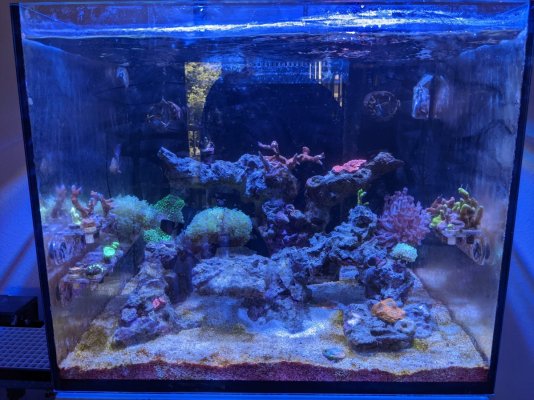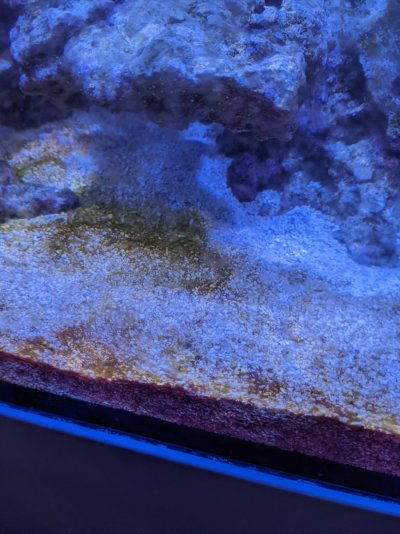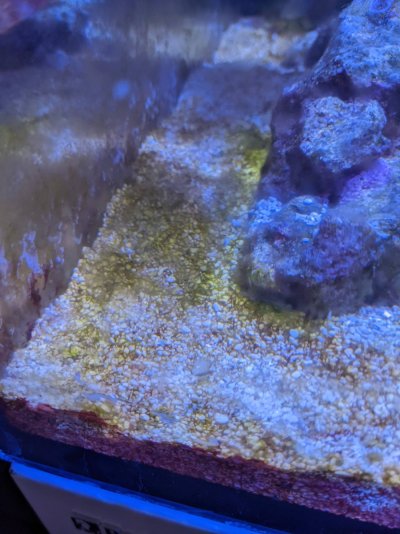Hi all,
I've got a tank that's been up for ~2-3 years, and it just won't stabilize. I'm stuck in a situation where my nitrate and phosphate are zero or nearly zero, but if I feed more I start getting tons of film algae growth on the glass and cyano growth on the sandbed/rocks. Same thing happens if I dose even small amounts of nitrate and phosphate. Same thing happens if I do less frequent water changes. Corals are surviving but looking a bit pale, for obvious reasons. I have some coralline algae growth, but it's not flourishing. Fish always seem happy and healthy. I've included as many details as I could think of below, hopefully someone can pinpoint what I'm doing wrong...I would greatly appreciate any tips or suggestions!
General tank features
I've got a tank that's been up for ~2-3 years, and it just won't stabilize. I'm stuck in a situation where my nitrate and phosphate are zero or nearly zero, but if I feed more I start getting tons of film algae growth on the glass and cyano growth on the sandbed/rocks. Same thing happens if I dose even small amounts of nitrate and phosphate. Same thing happens if I do less frequent water changes. Corals are surviving but looking a bit pale, for obvious reasons. I have some coralline algae growth, but it's not flourishing. Fish always seem happy and healthy. I've included as many details as I could think of below, hopefully someone can pinpoint what I'm doing wrong...I would greatly appreciate any tips or suggestions!
General tank features
- RSR 170 with sump
- ~30-40 lbs dry rock seeded with a few different bacteria in a bottle products (and some live reef rubble from AquaBiomics)
- Negative space, branching aquascape with very few dead spots
- 1.5-2 inches coarse white CaribSea aragonite dry sand, rinsed
- Sicce 1.5 AC return pump, full open
- Two Kessil A360s (intensity ramp from 0 to 50% over 3 hrs, hold at 50% for 4 hours, then ramp back down over 3 hrs), spectrum settings identical to intensity settings
- Two Aqua Gadget Midsize Pumps (253-2300 gph) set to 60% of max flow in sine wave mode, on upper back walls
- Comline 9004 protein skimmer, always on, cleaned and emptied once a week
- 1 PJ Cardinal, 1 Royal Gramma, 1 Coral Beauty Angelfish, 1 Yellow Watchman Goby, 1 pistol shrimp, and 1 Clownfish (removed due to aggression ~1 month ago)
- ~20-25 corals, mainly frags with a few colonies, some on rocks, some on shelves
- ~10-20 snails (mix of trochus, astrea, and cerith), tons of micro collonista snails, and 1 tiger sand conch
- Tons of amphipods and copepods, numerous bristle worms and spaghetti worms
- Alk ~9 dkH, Ca ~430 ppm, Mag ~1320, Phos ~0 ppm, Nitrate ~1 ppm, salinity ~35ppt, pH ~8.3
- I test all roughly once a week (Alk sometimes every few days) and all parameters are quite stable except phosphate which every now and then I'll notice spike up to ~0.1 ppm
- ~1/2 cube of frozen Ocean Nutrition Formula 1 or 2 (alternating) every day
- Auto feeder with Ocean Nutrition Formula 1 and 2 flake mix, adding a small pinch a couple times a day
- Once a week religiously, siphoning the sand bed, scraping film algae off glass, removing cyano patched when needed
- During each water change, sand bed is always quite dirty. Siphoning pulls out lots of white detritus/silt, water in collection bucket is always a cloudy brown.
- Started with Triton, switched to All For Reef a while back
- Daily dose of ~10ml All For Reef to keep alk ~9 dkH
- Ulva algae bed
- Kessil H160 grow light, on 6 hours at night (when display lights are off)
- A couple small chunks of live rock and rubble





















